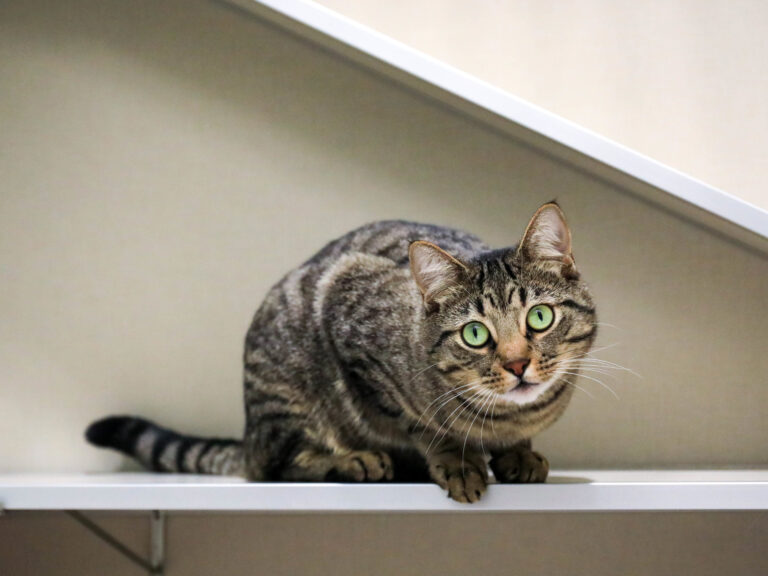
Adopting a Hoarded Cat
Cats that come from hoarding situations have spent most of their lives with other cats and many times have had very little contact with people. They can be fearful in new situations, especially when meeting new people and are usually not use to a litter box or carrier. However with time, patience, and positive reinforcement techniques like clicker training and play therapy, these cats will experience a reduction in their stress and become a part of the family.
What to Expect
When you first get your new cat home, she will be fearful and want to hide.
The best way to help her adjust to her new home is to set her up somewhere in your house that is small, like a bathroom. In this room, provide everything she will need; food, water, a litter box, a bed, and toys. Visit her every day, several times a day, doing positive things when with her, like offering high value treats or engaging in play. As she starts to become more comfortable, and is seeking attention, you can then let her out into the rest of your house. Start with another small area of your house though and build up to giving her total access.
She may not consistently use the litter box, especially if given too much space.
When a cat is afraid and hides, they may eliminate wherever they are hiding, especially a cat that hasn’t always used a litter box in the past. By placing your new cat in a small room, you are helping her to adjust and increasing the chances of her using the litter box. The more she uses the box, the more it becomes a habit. When your new cat is reliably using the litter box and is given access to the rest of the house, additional boxes are recommended to help ensure that she continues to use the box. It is also recommended to keep the original box in its original location if possible. If accidents occur, clean the soiled areas using a proper pet cleaner and use aversives to deter your new cat from re-visiting these spots (see our handouts: “Successful Cleaning to Remove Pet Odor and Stains” and “Aversives for Cats”).
She may always be fearful of new situations and new people.
Due to a lack of socialization, hoarding cats may always be quick to run and hide when people come over or loud noises occur. You can however help your new cat work through her fear and recover quicker. The best way to help her is by using positive reinforcement training techniques (see our handouts: “Positive Reinforcement: Training Your Cat with Treats and Praise” and “Cat Clicker training”). There are also several stress reducing products that can help your new cat adjust in fearful situations (see our handout: “Stress Relief for Your Pet”).
She may not handle being in a carrier. She may be vocal or struggle to get out.
Most often, the only times that a hoarding cat was ever placed in a carrier was the day they were taken from their home and during their time at the shelter. The best way to help your new cat be less fearful of the carrier is to work on positive reinforcement training, using the clicker as mentioned above. You can also leave the carrier out, allowing your cat to go in when she pleases and feed her treats in the carrier to help make better associations. Avoid bringing out the carrier ONLY when going to the vet.
She may never be a lap cat or enjoy being picked up and held.
Due to the lack of handling, hoarding cats are not use to being handled and may avoid siting in laps or struggle when picked up. You can prolong the amount of time your new cat will tolerate being handled though, using a food reward. Every time your cat comes near you when you are sitting down, reinforce her for staying using treats. If she ever gets into your lap, continue to reinforce her with treats but let her leave if she wants. When picking up, pair it with treats and remember to keep the handling to a minimum and build up the amount of time as she becomes more comfortable. Until she becomes more comfortable, you can positively interact with her in other ways though, like clicker training (as mentioned above) or play therapy (see our handout: Play with Your Cat).
She may do well in a home with other cats, due to living with many cats but there is no guarantee that she will get along with a new cat.
Due to the high volume of cats in a hoarding situation, most of them have spent their entire lives around cats and prefer the company of cats, however there are some hoarding cats that show evidence of cat fights when they arrive at the shelter and would do best in a home without another cat. Keep in mind though that even a cat that enjoys the company of other cats, may still not due well with a new cat. With proper introduction techniques, going slow, and using positive reinforcement, a hoarding cat can learn to co-exist with a new cat but again there are no guarantees. See our handout: “Introducing Your New Cat to Your Resident Cat” for proper introduction techniques.
What Not to Do
Never force your cat to spend time with her new family or new people. Allow her the chance to approach and reinforce her for interacting with people.
Never chase your cat. If you find yourself in a situation where you need to handle your cat for medicating or putting in a carrier, do not chase her around the house to catch her. Instead wait until she has settled somewhere, like her bed and then approach her. Do not encourage her to approach if bad things are going to happen, otherwise she will avoid approaching.
Never punish your new cat for house soiling, showing fearful behavior like hissing, or any other inappropriate behavior. Punishment will only make your new cat fearful of you and can lead to aggression. See our handout “The Fearful Cat.”

